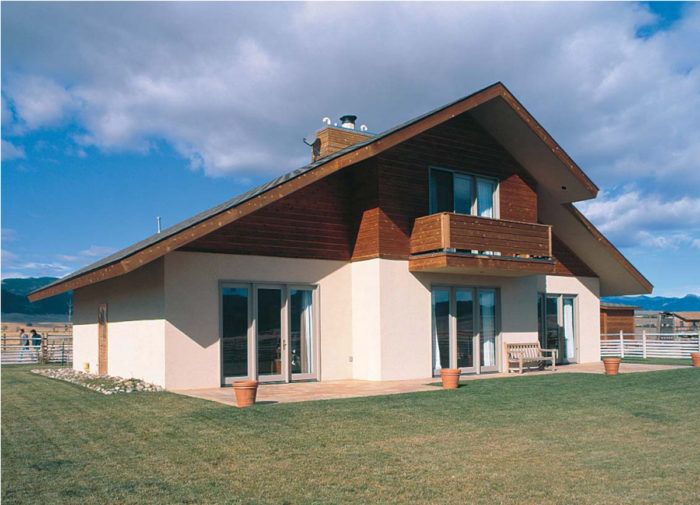Building a House of Insulated Concrete Block
Dry-laid walls reinforced with steel and filled with concrete make a weathertight, bugproof house.

Synopsis: This article describes the construction of an energy-efficient home suitable for Montana’s extreme climate using Rastra blocks, which are insulating forms made of concrete mixed with recycled polystyrene that can be stacked into walls, foamed in placed, and then filled with concrete.
Stick-frame construction is all but dead in Europe, and for good reason. Wood is too scarce and too expensive to use as a hidden structural element as it is in U.S. residential construction.
Instead, European builders use wood primarily for decorative details. Masonry construction is standard, as I learned in years of job-related travel that took me to Europe. When I moved to Montana a few years ago and built a house, the technologies I had seen in Europe made more sense than standard wood-frame construction.
Weather conditions in the mountains of southwestern Montana are brutal: scouring winds, 90°F summers and –40°F winters. The climate seemed ideal for one of the best European products I had seen, an insulated concrete block called Rastra. Developed in Austria, the block is a type of insulated concrete form that is dry-stacked, reinforced with steel, and then filled with concrete. Eighty-five percent of the material’s volume is recycled polystyrene, which is shredded into beads and mixed in forms with cement to make the block. Once completed, walls resist fire, earthquakes, wind, water, and insects. Houses built this way are unbelievably comfortable summer and winter, and pleasing to the eye to boot.
I am not a builder by trade. But my budget was tight, so I joined the construction crew that consisted of architect-builder Matthew Beardsley of the Baukunst Company in Bozeman, and one other person. We used block from a now-defunct company called Ener-Grid to build my house. It seems identical to the block manufactured by Rastra. Another company is Cempo Forms Inc. Techniques we used to build my house should work with block from either of these companies.
Blocks are lightweight, and workable with common tools
Ener-Grid blocks were available in widths of 8 in., 10 in., and 12 in., and 15 in. or 30 in. high. Each block is 10 ft. long (sizes may vary, depending on which manufacturer you buy from). For all their bulk, however, blocks are relatively light. The 10-in.-deep, 15-in.-high blocks that we used weighed 160 lb. each. To move them, we used a rented farm tractor equipped with a simple clamp. Once we were on the second floor, we also used a portable aluminum hoist.
The material is easily cut with a chainsaw or handsaw. It can be routed, drilled, sanded, rasped, shaped and set into curves. That’s the real beauty of the material: Its applications are limited only by your imagination. Running through the block, both horizontally and vertically, are 6-in.-dia. cores 15 in. o. c. where steel-reinforcing bar and, ultimately, concrete are placed. Once filled, the blocks form a continuous, reinforced grid of incredible strength.
For more photos, drawings, and details, click the View PDF button below:
Fine Homebuilding Recommended Products
Fine Homebuilding receives a commission for items purchased through links on this site, including Amazon Associates and other affiliate advertising programs.

100-ft. Tape Measure

Smart String Line

Plate Level


























